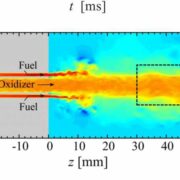Advancement in interpreting birth of supermassive Black holes

A studies group led by using Cardiff University scientists say they are toward expertise how a supermassive black hole (SMBH) is born thanks to a new method that has enabled them to zoom in on this kind of enigmatic cosmic objects in unheard of detail.
Scientists are uncertain as to whether or not SMBHs were fashioned in the intense situations quickly after the large bang, in a procedure dubbed a ‘direct collapse’, or had been grown a lot later from ‘seed’ black holes as a result of the dying of big stars.
If the former technique have been actual, SMBHs could be born with extremely huge masses—loads of heaps to hundreds of thousands of instances more big than our Sun—and might have a set minimal size.
If the latter have been proper then SMBHs could start out noticeably small, round 100 times the mass of our Sun, and start to grow larger over the years by feeding on the stars and gas clouds that stay around them.
Astronomers have lengthy been striving to find the lowest mass SMBHs, which are the missing links needed to decipher this problem.
In a observe published today, the Cardiff-led team has driven the boundaries, revealing one of the lowest-mass SMBHs ever observed on the centre of a close-by galaxy, weighing much less than 1,000,000 instances the mass of our sun.
The SMBH lives in a galaxy that is familiarly regarded as “Mirach’s Ghost”, due to its near proximity to a completely vivid star referred to as Mirach, giving it a ghostly shadow.
The findings have been made the use of a new method with the Atacama Large Millimeter/submillimeter Array (ALMA), a trendy telescope situated excessive at the Chajnantor plateau in the Chilean Andes this is used to examine mild from some of the coldest items within the Universe.
“The SMBH in Mirach’s Ghost seems to have a mass inside the range anticipated by means of ‘direct collapse’ fashions,” said Dr. Tim Davis from Cardiff University’s School of Physics and Astronomy.
“We know it’s miles presently lively and swallowing fuel, so a number of the greater extreme ‘direct collapse’ models that handiest make very large SMBHs can’t be true.
“This on its personal is no longer enough to definitively tell the difference between the ‘seed’ photo and ‘direct collapse’ – we need to apprehend the facts for that—however that is a massive step in the proper direction.”
Black holes are objects that have collapsed beneath the burden of gravity, leaving in the back of small but rather dense regions of area from which not anything can escape, not even mild.
An SMBH is the largest form of black hole that can be loads of heaps, if no longer billions, of instances the mass of the Sun.
It is assumed that nearly all big galaxies, together with our own Milky Way, contain an SMBH positioned at its centre.
“SMBHs have additionally been observed in very distant galaxies as they appeared only some hundred million years after the big bang”, said Dr. Marc Sarzi, a member of Dr. Davis’ team from the Armagh Observatory & Planetarium.
“This propose that at the least some SMBHs could have grown very big in a very quick time, which is hard to explain in line with fashions for the formation and evolution of galaxies.”
“All black holes grow as they swallow fuel clouds and disrupt stars that assignment too near them, but a few have greater energetic lives than others.”
“Looking for the smallest SMBHs in nearby galaxies ought to therefore assist us screen how SMBHs start off,” persisted Dr. Sarzi.
In their observe, the international crew used emblem new strategies to zoom further into the coronary heart of a small close by galaxy, known as NGC404, than ever before, allowing them to study the swirling fuel clouds that surrounded the SMBH at its centre.
The ALMA telescope enabled the crew to solve the gas clouds in the coronary heart of the galaxy, revealing details only 1.5 million years across, making this one of the maximum decision maps of fuel ever made from every other galaxy.
Being in a position to observe this galaxy with such high decision enabled the team to conquer a decade’s really worth of conflicting results and monitor the actual nature of the SMBH on the galaxy’s centre.
“Our examine demonstrates that with this new technique we can sincerely start to explore each the residences and origins of these mysterious gadgets,” continued Dr. Davis.
“If there’s a minimum mass for a supermassive black hole, we haven’t discovered it yet.”
The outcomes of the observe had been published today within the Monthly Notices of the Royal Astronomical Society.

























